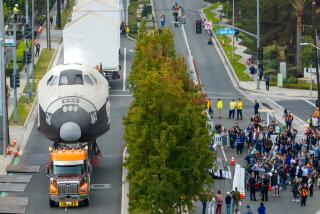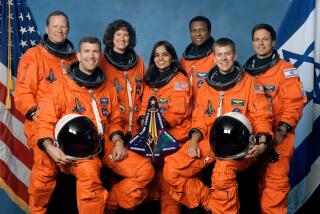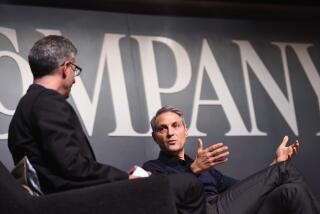Reflecting on Endeavour’s momentous journey
- Share via
Spare parts were collecting dust in warehouses in Bell, Downey and Palmdale when the urgent call came from NASA: the nation needed another space shuttle.
It was the unusual beginning of the orbiter Endeavour, which will streak across the California coastline at hypersonic velocity one last time Wednesday, carrying its six astronauts and two decades of the nation’s human space flight history.
When it was christened in Palmdale in 1991, it was the newest and most capable of the fleet, fawned over by astronauts for its advanced flight electronics, sinuous skins and, eventually, the first toilet that actually worked.
Photos: Endeavour’s final flight
“It was a real clean bird,” said Robert “Hoot” Gibson, the Navy aviator who flew Endeavour the year it entered service in 1992. “We didn’t have any issues with that machine.”
But it began its life amid a political scheme to circumvent opponents by squirreling away spare parts in the hope they would someday amount to a real spacecraft.
When the Challenger was lost in an explosion in 1986, the spare-parts plan was vindicated and they suddenly became the starting point for keeping the shuttle program alive.
And now the ship will come back home a museum piece in the county where it was built, destined for a display at the California Science Center in Los Angeles. The last shuttle flight is scheduled to launch July 8, after decisions by the Bush and Obama administrations to end the program.
During Endeavour’s 24 previous journeys, which covered more than 103 million miles, astronauts engaged in all kinds of breathtaking, often scientifically incomprehensible and occasionally bizarre exploits.
In its current flight, the orbiter is helping to complete the International Space Station. Over the years, it helped repair disabled satellites, grow proteins and serve as maternity ward for pregnant frogs. In 1996, it flew a Coke machine that malfunctioned.
Endeavour delivered one of the most spectacular space feats short of a moon landing in December 1993, when it flew into high orbit and dazzled the nation with the Hubble Space Telescope repair mission.
The flight took Endeavour to an orbit about 350 miles high, forcing engineers to check whether every piece of its structure could handle the higher stress on reentry, recalled Bill Novak, a Boeing engineer in Huntington Beach who has worked on the program for nearly 39 years.
Without the shuttle’s unique architecture, equipment and propulsion system, Hubble would have been left permanently out of focus.
“Every time I see new pictures of the universe from Hubble, it is rewarding,” said Ken Bowersox, the Endeavour pilot who grappled Hubble with the orbiter’s robotic arm. “It was a big mission, but there were a lot of big missions. You couldn’t find the most important one.”
Indeed, at the end of its life, there is wide agreement that Endeavour and its sister orbiters served the nation well.
The space shuttle was maligned during much of its history for failing to meet the promise that it could drive down the cost of reaching orbit and serve as a single means of launching defense, commercial and scientific payloads.
The program was dogged for decades by questions over its very purpose. It often had interminable launch delays. Two accidents scarred the program and left the nation mourning the deaths of 14 men and women.
The Challenger accident in 1986 led the Defense Department to abandon plans to use the shuttle to launch military spacecraft. And the Columbia breakup during reentry in 2003 led investigators to conclude that the craft was “inherently risky,” a death sentence for the program.
But in hindsight, the shuttle program exceeded by a wide margin the capabilities of any other nation, taught astronauts how to routinely work in space and paved the way for an astounding number of breakthroughs, according to scientists, astronauts, engineers and government officials.
“It gave us the capability to expand our knowledge of the universe,” said NASA chief Charles Bolden, a former shuttle commander.
It helped make peace with Russia after the end of the Cold War and brought women and minorities into space for the first time, Bolden said.
Endeavour was the star of the fleet, the one chosen to fly some of the most difficult missions. By the time it was produced at Rockwell International’s Downey and Palmdale plants, engineers had already fine-tuned the design and manufacturing process. As a result, it was the lightest and sleekest of the fleet.
“You could look down the belly and see the difference,” said Gerald Kinder, a Boeing aerodynamic heating engineer who has worked on the shuttle program for 30 years.
A bump of just 1/10 of an inch on a heat tile could cause a temperature increase of 500 degrees and Endeavour had the fewest bumps, Kinder said. On the current mission, Kinder has an experimental bump to further refine engineering know-how about such nonconformities for future spacecraft. He will be waiting for the data in the weeks after it lands.
But for all of Endeavour’s attributes, engineers made every effort to keep the shuttles similar to one another, making the job of flying the shuttle less complicated for the pilots.
“A shuttle is a shuttle. They are all pretty much the same. That’s the whole point,” said Allen Richardson, a former structures engineer at Rockwell, which later became part of Boeing.
When Richardson helped oversee the shuttle’s design in the 1970s, nobody had computer terminals on their desks and engineers walked around with stacks of punch cards, he recalled. In his garage, he keeps his old weekly status reports on Endeavour and the other shuttles.
“If you look at these old reports, wow, you wonder how we dealt with these problems,” he said. “But it worked. And it still does.”
But not for long. When Endeavour lands Wednesday, it will be prepped for public display — and even that is a much bigger job than it might seem.
Bill Roberts, a Boeing engineer, has spent the last five years researching and writing a report on how NASA will decommission the shuttles, producing a manual called the “End State Subsystem Safing Requirements Document.”
A lot of the guts of Endeavour will be cut up. The liquid engines will be removed and stored by NASA for future engine research. Lines that carry toxic hypergolic fuels will have to be removed, along with valves and tanks.
“The orbiters are definitely not going to be flightworthy,” Roberts said.
The practical destruction of the shuttles leaves a lot of bitter feelings among some proponents who have been arguing for the last year that the nation is making a colossal mistake by retiring the fleet. Built to withstand 100 flights, Endeavour made only 25, meaning it has a lot of life left in it.
“Shutting down the shuttle will put us back 50 years,” said George Jeffs, the former Rockwell executive who ran the shuttle manufacturing program in the 1970s. “The shuttle is an all-in-one space construction company. If you want to go to Mars, the shuttle would be the best way to assemble an interplanetary vehicle in space.”
The United Space Alliance, the joint venture that helps NASA operate the shuttle, told NASA that it could keep flying the fleet for less than half of the 2010 budget of $3.1 billion, said Executive Vice President Daniel Brandenstein, who was also the commander of Endeavour’s first flight.
Brandenstein said he still marveled at the remarkable flight control that the shuttle provided astronauts. On its maiden flight, the Endeavour was supposed to repair a stranded communications satellite. After two unsuccessful attempts, the crew was distraught, he recalled.
And then NASA gave the go-ahead for something nobody ever had attempted or trained for: a three-man space walk in which the astronauts would use sheer muscle to grab the satellite. With the astronauts strapped on outside platforms, Brandenstein had to manually fly the shuttle right up to satellite, putting the lives of his crew in the dexterity of his trigger finger.
“I am convinced it is the best flight-control system ever designed,” he said.
Bill Barry, NASA’s chief historian, said the real value of the shuttle had yet to be measured.
“In the future,” he said, “people will look back and say, ‘How could they have built something like that that could do so many things?’ ”
Photos: Endeavour’s final flight
More to Read
Sign up for Essential California
The most important California stories and recommendations in your inbox every morning.
You may occasionally receive promotional content from the Los Angeles Times.











